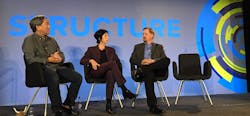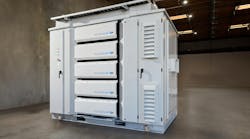Structure 2015 – What I Learned Hanging Out With Some Of The Coolest People In IT
This week’s “Voices of the Industry” column is from James Leach, Vice President, RagingWire Data Centers discusses what he learned at the recent Structure conference.
JAMES LEACH, RagingWire Data Centers
The Structure Conference is a great place to find that spark of technology innovation. The two-day conference features 20-minute interviews by top-notch journalists with leading internet entrepreneurs, investors, and application developers. The journalists mostly come from Gigaom. The speakers aren’t just “big thinkers,” they’re “big doers” as well.
I just returned from Structure 2015. If you could not attend Structure, I thought you might be interested in some of the top learnings from the event.
“Infrastructure Buddhism”
Everything we do in IT is driven by an application. According to Raj Patel (@rmpatel1), Head of Cloud Engineering at Pinterest, we should all be practicing “Infrastructure Buddhism,” learning to separate ourselves from our infrastructure in order to heighten our other senses.
Make no mistake, infrastructure matters to Pinterest. They process 150,000 requests per second. Their compute capacity grew by 2x last year, and storage grew by 3x. But they want to build an application environment where developers don’t need to touch infrastructure. This approach requires data centers that can scale with demand and deliver 100% availability.
“The Data Center Tipping Point”
There was quite a bit of discussion related to a phrase coined by Tom Krazit (@tomkrazit), former Executive Editor of Gigaom, called “the data center tipping point.”
Workday’s Senior Vice President of Technology Development, David Clarke (@DavidOwenClarke) believes their three data centers (two in the U.S. and one in Europe) enable them to deliver secured, grid-oriented processing where they are continually evolving their application system. For Clarke, “Business data is different than consumer data. You won’t give me your data if I’m going to hand it over to someone else.”
According to Pinterest’s Patel, workload drives the infrastructure decision. Pinterest built their business on Amazon Web Services (AWS) because of the “velocity” the public cloud provided. However, he believes there could be uniform workloads that might point to in-house systems and data centers.
Lastly, Mike Krieger (@mikeyk), Co-founder of Instagram, and Jay Parikh (@jayparikh), VP Global Engineering and Infrastructure at Facebook (Instagram’s parent), talked about how Instagram migrated from AWS to Facebook’s private cloud through a process called “Instagration.” The cost savings and performance improvements were significant. Every three AWS servers were replaced with one Facebook server. Upload performance improved by 80%. According to Krieger, using the Facebook cloud produced people savings too. Instagram has 400 million users and only 14 infrastructure people.
“You Won’t See Computing”
Almost every speaker at Structure gets asked to give an idea of the future of IT.
Google’s Urs Holzle (+UrsHolzle), Senior Vice President, Technical Infrastructure and Google Fellow, had an interesting response. “In 2020 you won’t see computing anymore. Applications will understand the task you are trying to accomplish and derive the context from the world around them. There will be less input and better functionality.”
Vinod Khosla (@vkhosla) was called a “legend among legends” at Structure 2015. As the founding CEO of Sun Microsystems and now Founder of venture capital firm Khosla Ventures, he is at the forefront of innovation and entrepreneurship. Khosla believes we must look to start-ups for future innovation. “Who is inventing the future that is changing the world? The old tech companies are mostly financial engineering. Innovation happens when you imagine the future, and make it happen.”
Are Containers The Next Big Thing?
Almost every speaker at Structure mentioned containers as the next big thing. Leading container technologies Kubernetes (open sourced from Google), Mesos (open sourced from Apache), and Docker (open sourced out of dotCloud) were all discussed. There were no disagreements that containers were a good thing. There was some discussion on whether containers were a new thing.
According to Eric Brewer (@eric_brewer), Vice President Infrastructure at Google, “Containers are the modern distributed object. They unlock the magic.”
Florian Leibert (@flo), Co-founder and CEO at Mesosphere, said, “Mesos APIs can be used to create a big pool of resources in the data center and the cloud.”
Marianna Tessel (@docker), Vice President Engineering at Docker, talked about how containers are the key to distributing applications and moving workloads between clouds.
Bryan Cantrill (@bcantrill), Chief Technology Officer of Joyent, made the case that containers, while good, actually aren’t all that new in concept. Today’s containers are based on a long history of operating system virtualization starting with chroot in Unix, then jails from FreeBSD, and finally zones in Solaris.
Data Centers Matter
Two key points about data centers were brought up by William Dougherty (@bdognet), Senior Vice President and Chief Technology Officer at RagingWire.
First, the cloud lives in a data center. In fact, the more the cloud grows, the more we need data centers. If the clouds are mission critical, then they need a data center that is secured, connected, massively scalable, and 100% available.
Second, the data center required for this cloud world needs to be heavily instrumented with sensors and real-time monitoring throughout the facility. Think of a data center as an internet of things – a building that uses sophisticated software systems and programmable logic controllers (PLCs) to expand, contract, and move the power, cooling, and network it delivers.
Don’t Forget – Technology Is About People
Structure is filled with talk about the cloud, coding, and innovation. Jeff Wile, Vice President Hosting and Engineering Services at Disney, reminded us all that people are a critical part of the technology equation. “People are the key to making this all work. Find courageous, curious people to seed the organization. Provide them the tools and training to empower the creative process.”
Footnote: Fun Action Items From Structure
1.) Follow Ashlee Vance (@valleyhack) on Twitter. Ashlee Vance is a technology writer for Bloomberg Businessweek in Palo Alto, Calif. He is the author of “Elon Musk: Tesla, SpaceX, and the Quest for a Fantastic Future.” Vance was mentioned by Vinod Khosla as a good source on the future of technology. The Wired article “Dell. EMC. HP. Cisco. These Tech Giants Are the Walking Dead” which quotes Vance was also recommended.
2.) Use Jevon’s Paradox. Mentioned by Bryan Cantrill, Chief Technology Officer at Joyent, Jevon’s Paradox (or Effect) was described by economist William Stanley Jevons in 1865. The paradox says that as efficiency increases (meaning less is needed for a unit of work), consumption actually goes up not down (due to increased demand).
3.) Read the new book “Digital Disciplines” by Joe Weinman (@joeweinman). Joe has been a mainstay at Structure. This year he presented the core concepts of his new book which takes the the Value Disciplines strategic model published by Michael Treacy and Fred Wiersema in the early 1990’s and updates it for the digital age.
4.) Watch the Structure 2015 session on “The Future of the Data Center” featuring RagingWire and Digital Realty Trust. And watch the follow-up interview on theCUBE with William Dougherty, CTO of RagingWire.
James Leach is the Vice President Marketing at RagingWire Data Centers. As a marketing executive, sales leader, and systems engineer, James Leach has enjoyed a 30-year career building technology and services businesses for commercial and government organizations. For the last 15 years, Mr. Leach has been at the forefront of developing innovative internet services for enterprises. He was part of the core team that introduced ultra-high availability data center colocation, second generation cloud computing solutions, virtual private networks (VPNs) and route optimization, application hosting, content delivery networks (CDNs), internet registry and DNS (domain name system) services, and web performance monitoring and testing.


